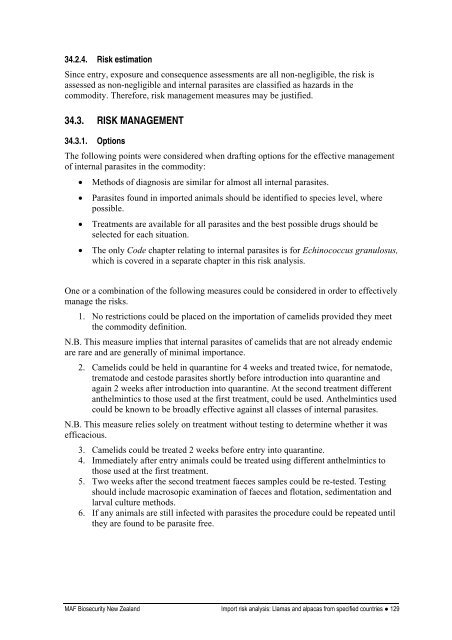Import risk analysis: Llamas (Lama glama) and alpacas (Vicugna ...
Import risk analysis: Llamas (Lama glama) and alpacas (Vicugna ...
Import risk analysis: Llamas (Lama glama) and alpacas (Vicugna ...
You also want an ePaper? Increase the reach of your titles
YUMPU automatically turns print PDFs into web optimized ePapers that Google loves.
34.2.4. Risk estimation<br />
Since entry, exposure <strong>and</strong> consequence assessments are all non-negligible, the <strong>risk</strong> is<br />
assessed as non-negligible <strong>and</strong> internal parasites are classified as hazards in the<br />
commodity. Therefore, <strong>risk</strong> management measures may be justified.<br />
34.3. RISK MANAGEMENT<br />
34.3.1. Options<br />
The following points were considered when drafting options for the effective management<br />
of internal parasites in the commodity:<br />
� Methods of diagnosis are similar for almost all internal parasites.<br />
� Parasites found in imported animals should be identified to species level, where<br />
possible.<br />
� Treatments are available for all parasites <strong>and</strong> the best possible drugs should be<br />
selected for each situation.<br />
� The only Code chapter relating to internal parasites is for Echinococcus granulosus,<br />
which is covered in a separate chapter in this <strong>risk</strong> <strong>analysis</strong>.<br />
One or a combination of the following measures could be considered in order to effectively<br />
manage the <strong>risk</strong>s.<br />
1. No restrictions could be placed on the importation of camelids provided they meet<br />
the commodity definition.<br />
N.B. This measure implies that internal parasites of camelids that are not already endemic<br />
are rare <strong>and</strong> are generally of minimal importance.<br />
2. Camelids could be held in quarantine for 4 weeks <strong>and</strong> treated twice, for nematode,<br />
trematode <strong>and</strong> cestode parasites shortly before introduction into quarantine <strong>and</strong><br />
again 2 weeks after introduction into quarantine. At the second treatment different<br />
anthelmintics to those used at the first treatment, could be used. Anthelmintics used<br />
could be known to be broadly effective against all classes of internal parasites.<br />
N.B. This measure relies solely on treatment without testing to determine whether it was<br />
efficacious.<br />
3. Camelids could be treated 2 weeks before entry into quarantine.<br />
4. Immediately after entry animals could be treated using different anthelmintics to<br />
those used at the first treatment.<br />
5. Two weeks after the second treatment faeces samples could be re-tested. Testing<br />
should include macrosopic examination of faeces <strong>and</strong> flotation, sedimentation <strong>and</strong><br />
larval culture methods.<br />
6. If any animals are still infected with parasites the procedure could be repeated until<br />
they are found to be parasite free.<br />
MAF Biosecurity New Zeal<strong>and</strong> <strong>Import</strong> <strong>risk</strong> <strong>analysis</strong>: <strong>Llamas</strong> <strong>and</strong> <strong>alpacas</strong> from specified countries ● 129

















